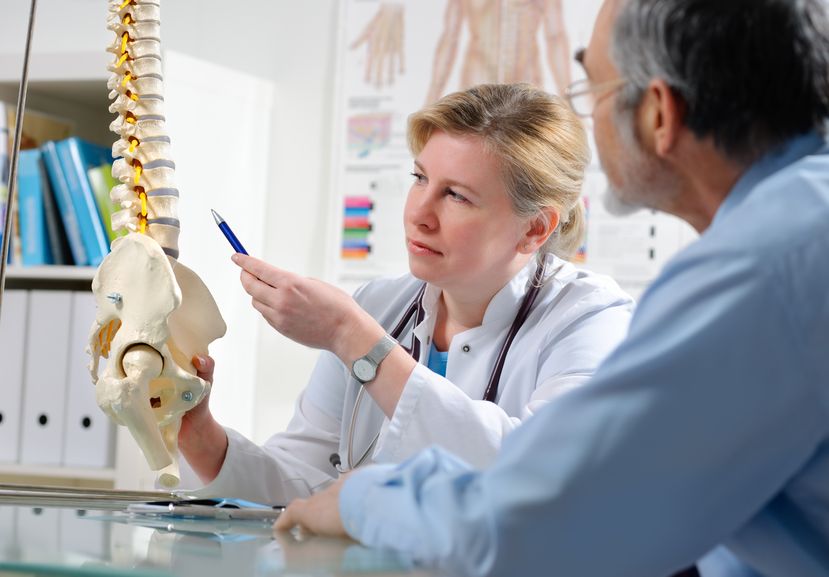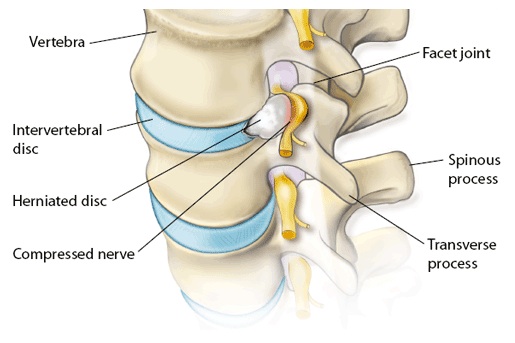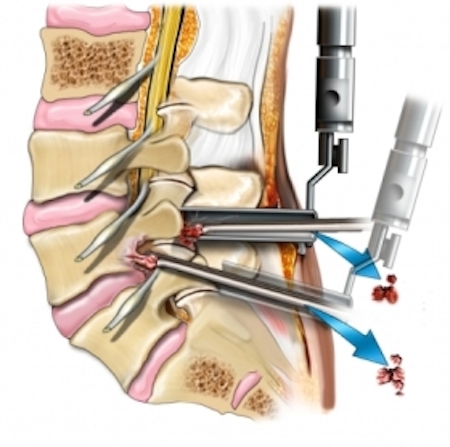Partial Lumbar Discectomy and Recovery

Tid Bits of Info
- The spine has been shown to “crumble” under less than 20lbs of superior weight. The dynamic support from the muscles is critical.
- If you have pain extending into your lower extremity (s) seek medical help from your doctor or Physical Therapist.
- Many neurosurgeons perform Lumbar discectomies, but do not promote attending formal Physical Therapy sessions. BE PRO-ACTIVE.
- Repetitive flexion of the waist (bent over) can lead to a ruptured/herniated disc.
- The layman’s term “slipped disc” is a ruptured or herniated disc.
Lumbar Discectomy can be an effective treatment for low back pain when patients adhere to protocols from the surgeon and Physical Therapist. Low back pain is common and can often be treated through out-patient Physical Therapy. Severe pain due to an injury or some type damage to the disc resting between the vertebrae may require a range of conservative treatments including mediation and rest, but this still may not be enough. Lumbar Discectomy surgery may then be necessary to fix the damaged area and eliminate the source of the symptoms.
Low Back Pain from Ruptured Disc
The lumbar spine consists of 5 vertebra that are positioned in a “C” shape curve. These 5 bones are separated by shock absorbing discs that have a hard outer shell (annulus) and a gel like inside (nucleus pulposus). These discs are extremely durable, but they can suffer damage. As we age or if the sheer or compressive force is too great, the outer shell can crack or rupture. The function of the disc is lost if it “ruptures” and the outer wall or Annulus tears. The tearing of the Annulus enables the inner material, nucleus pulposus, to escape and put pressure on a nerve root at the level of the damage.
If the material or a piece of the outer wall touches one of the nerve roots, the symptoms can be debilitating. When conservative treatment fails to resolve the symptoms, the patient will need to have Lumbar discectomy, a surgical procedure to remove the material from the nerve root.
Partial Lumbar Discectomy
Partial lumbar discectomy is a surgical procedure that involves removing the ruptured disc fragment. This surgery is usually performed as out-patient procedure. The patient is encouraged to stand up and walk with in 12-24 hours of the surgery.
The surgeon’s approach is usually from the posterior aspect of the spine. The patient in placed in a prone position and flexed at the waist. There is small incision made at the level of the damage and the surgeon locates the damaged disc by separating a small portion of the Lumbosacral Fascia and paraspinal musculature away from the vertebrae.
The disc material that has migrated out of the disc and pieces of the annulus that might have “broken” off are removed from the nerve root. The Lamina is partially removed to “open” the foramen that houses the involved nerve root. The removal of a small portion of the lamina is referred to a partial Laminectomy. After the removal of a portion of the Lamina, the involved nerve is no longer compressed and has much more space to course through.
Post Lumbar Discectomy Physical Therapy
Once the procedure is complete, the patient will be instructed to walk with in hours of the procedure. They will continue to walk several times per day to help the healing process and decrease the possibility of developing secondary health conditions that are closely related to being too sedentary.
The surgeon will determine when a formal Physical Therapy program can begin (normally a few days after procedure). Program intensity will be very low until the incision has healed. This healing process usually takes 2-3 weeks to completely heal. At that time, the patient will be much more mobile and comfortable while changing positions which enable them to perform most of the initial rehabilitation activities and exercises with minimal pain and discomfort.
The initial Physical Therapy program should include cardiovascular exercises, general whole body stretching and strengthening and education on proper body mechanics and ergonomics to prevent excess stress and strain on the surgically corrected lumbar spine. The Physical Therapist will generate a rehabilitation program that will re-develop the patient’s flexibility, muscular strength, endurance and proprioception of the Lumbar spine.
What to Expect if You Have a Partial Lumbar Discectomy:
Pain: Everyone has different pain tolerances. The surgeon will prescribe pain medication, and you should apply ice to the area as often as possible during the first 48-72 hours post – op. You will experience less pain if you are able to get up and move around slowly (always adhere to the doctor’s restrictions). Too much lying or sitting will lead to a decrease in blood flow to the surgery area. Bi-products of healing remain in the surgery site and become an irritant to the nerves that produce and transmit a “pain signal” to the brain.
Weight bearing: You will be encouraged to stand up and walk with in the first 12-24 hours of the post op time period. You might have to have assistance or use an assistance device during the immediate time period following the surgery. You also might have experienced weakness and pain in one or both legs prior to surgery. The pain may cause significant difficulty, forcing you to use assistance.
Splint / Bracing: You will wake up from surgery with bandages on the incision, but most likely will not be required to wear any kind of support bracing. More extensive Lumbar spine surgeries require braces, but not a partial discectomy.
Sleeping: Finding a comfortable position to sleep can be difficult during the first couple of days/weeks following surgery. Most patients will be able to lie on one side or the other with a pillow between their knees, which will enable them to be comfortable enough to fall asleep and remain asleep for a period of time.
Motion: Your surgeon will give you any restrictions based on the severity of the surgical procedure. In most cases, your surgeon will ask you to be relatively sedentary for a period of a couple weeks. The doctor does not want you to do too much and cause more irritation to the area, which could lead to a significant rise in the pain level. The surgeon will encourage you to move slowly but in almost any direction. “Pain” serves limiting factor to your motion. You should never experience sharp pain or radiating pain into your legs.
Driving: You cannot take pain medication and drive. If the law enforcement professional stops you, you will get a driving under the influence citation. Your surgeon will restrict you from driving for a couple days/weeks. You will not be allowed to drive until they have complete control of your core and lower extremity musculature. Also, you must be able to maneuver in and out of the car and be able to move your legs to control the pedals of the car.
Returning to work: This decision will have to be made by you and your doctor. This is fully dependent upon the type of job that you have. If you have a sedentary job, you might be able to return with in the first week of the post op period. If you have a physically demanding job, you might be out of work for several months.
Having fun: You, your doctor and Physical Therapist can decide when you return to the “fun” things in your life. Workouts, dancing, hiking, recreational sports, gardening, shopping and any other weight bearing activity can begin to take place when the surgically repaired disc is fully healed. The time frame for complete healing is dependent upon how severe the damage was in the first place. In most cases, the first 3 weeks requires a relatively sedentary lifestyle. The time period between week 4 and 12 will be the time when most of the disc and bone healing commences. During this time period, your Physical Therapist can guide your progression, which will be determined by the pace that the disc is healing, the reduction of swelling, decreased pain and increased muscle response in the low back. Dynamic support of the spine which is provided by the paraspinal musculature must occur or the Lumbar spine can be injured or develop symptoms that are similar to the pre-surgery symptoms.
Fortunately, the need for a partial Lumbar discectomy can be reduced drastically by performing a sound rehabilitation program. If surgery is needed, the patient must be pro-active and request that they be sent to a Physical Therapist who is well versed in post- surgical Lumbar spine rehabilitation. Performing a proper rehabilitation program can help to restore the normal levels of pre-surgery function in almost all patients.



























A rolled up mat would not work very well, becsuae it doesn’t have a hard enough core. PVC pipe can be used, which is VERY hard, and may be too intense for a beginner. I personally use PVC pipe with a piece of an old yoga mat glued on it for more cushion, but this is still very intense. I use it only when I can’t release? the knots with regular foam rolling. I have also heard of using a 2 L plastic pop bottle, with water that is frozen in it. I have not tried this-it would be intense as well.